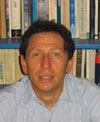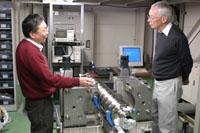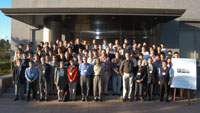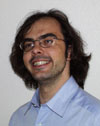 |
|
|
 |
Guy Wormser, New Director
of LAL
"The ILC projects comes at a very strategic moment. It would allow to deepen in a spectacular way the discoveries we all expect to see at the LHC (a program on which the LAL is very heavily involved) and lead to some other exciting new phenomena as well. No time therefore should be lost to embark in an ILC at the end of this decade." - Guy Wormser

Guy Wormser
|
Guy Wormser has been named Director of the Laboratoire de l'Accélérateur Linéaire at Orsay (LAL), the largest laboratory of CNRS/IN2P3 devoted to particle physics, effective 1 September 2005. The feature of the laboratory is to conceive, build and operate large and sophisticated equipment in the framework of international collaborations "It is natural to find LAL Orsay very deeply involved in the very challenging ILC project, which fully match to LAL interest and vision," said Wormser in a recent interview.
The program of the laboratory for the ILC is presently quite wide: from the high power RF couplers in the heart of the Linac, new ideas on polarimetry and Compton based polarised positron source, a strong machine-detector interface involvement, beam instrumentation, to gaseous tracking systems and innovative R&D in the electronics of the ILC detector calorimeters.
The laboratory is also a strong participant since many years in the CLIC R&D program at CERN, giving the community the tools it would need to explore this extreme domain. "The quest for solving Nature deepest secrets will not be over however, at the end of the LHC and ILC scientific programs. It is very likely that we would then need to explore with the same extreme accuracy as the one provided by ILC the energy region of a few TeV," said Wormser.
Member and chairman of numerous international committees, Guy Wormser was named Deputy Director of IN2P3 from 1999 to 2003 during the critical years of LHC construction. Interested by computing issues of the LHC experiments and member of the LCG committees, he recently created and chairs a new ICFA panel devoted to International HEP Computing coordination. He also co-chairs the French GDE project for the ILC.
Announcement from Interactions.org
--Perrine Royole-Degieux
|
 |
|
|
 |
Upcoming meetings, conferences, workshops
European Industry Forum for SCRF Accelerator Technology
DESY, Germany, 27 October 2005
Damping Rings Meeting
CERN, Switzerland, 9-11 November 2005
ECFA ILC Workshop
Vienna, Austria, 14-17 November 2005
TESLA Technology Collaboration Meeting
Frascati, Italy, 5-6 December 2005
GDE Meeting
Frascati, Italy, 7-10 December 2005
2006 LCWS 2006
Bangalore, India, 9-15 March 2006
|

Bill Willis watches 9-cell ICHIRO cavity during his visit
to KEK on November 20.
|
|
 |
 |
|
|
 |
Low Emittance Beams in Focus at Nanobeams 2005

The attendees at the Nanobeams 2005 meeting in Kyoto, Japan.
|
Last week's Nanobeams 2005 workshop made progress toward developing solutions for producing and preserving low emittance beams. In the International Linear Collider design, the colliding beams will be only five nanometers high and several hundred nanometers wide - not an easy feat.
"For the linear collider, we will have to make the beam sizes ('emittances') very small and then preserve them through most of the accelerator," said physicist Phil Burrows, of Queen Mary, University of London, who attended the meeting. "At Nanobeams, we focused on the issues of creating the beams and preserving their small emittances to keep nanometer- sized beams hitting each other again and again. There are lots of things that conspire to prevent that though."
Burrows explained that cultural noise such as road traffic, rail traffic and general seismic vibrations all have an impact near delicate facilities. "There was a lot of discussion on sources of vibrations and trying to damp and compensate for them," he said. "Finding the right site for the ILC is very important."
Even though these vibrations are so small a person cannot detect them, a machine that has nanometer size beams such as the ILC would be so delicate that muting this noise is essential. In order to counteract these vibrations, ILC scientists are exploring many different solutions. One strategy is to damp out the vibrations by cushioning the most critical machine components. Another strategy is to compensate for this noise by determining exactly how things are vibrating, and then compensating for the motion using control systems and active feedback systems. Civil engineers are taking these factors into consideration for the ILC site studies, and prototypes for damping and stabilizing systems are now being developed.
Burrows is analyzing another option for protecting the beams from vibrations. "When all else fails, move the beam," he said. "Vibrations of the magnets can talk to the beam and move it. You can build a feedback system that will detect the moving beams and compensate for the motion with a magnetic kick. The electron and positron beams can then be steered into collision. Moving the beam is the last defense you have."
All of the talks from the Nanobeam 2005 meeting are available online. Scientists propose to host the next Nanobeam meeting in Russia in 2008.

Scientists focused on producing and preserving low emittance beams for the ILC at Nanobeams 2005. The next Nanobeams meeting will tentatively take place in Russia in 2008.
|
--Elizabeth Clements
|
 |
|
|
 |
|
 |
 |
|
|
 |
Positron Production
Last week I discussed the recommendation from Snowmass for the baseline electron source to be used for the linear collider reference design, and today I will briefly discuss the more challenging positron source. One of the consequences of having made the choice of superconducting RF technology for the main linac of the linear collider is that the machine pulse structure is such that more electrons and positrons are required per bunch. In fact, the resulting requirement is for 2 1010 particles for 2820 bunches per pulse or half that for 5600 bunches per pulse. This is a quite challenging requirement for positron production, although it does appear possible.
Three candidate schemes for positron production have been proposed: a helical undulator- based source; a conventional source; and a laser Compton based source. All three were presented, discussed and compared at Snowmass. The pluses and minuses of the three schemes make the choice a difficult one; however, after considerable discussion a set of recommendations were made by the end of the workshop. Those recommendations are now under discussion and consideration, and we expect that a final decision for the baseline positron source will be made at the Frascati GDE meeting in December.

Phillipe Piot
|
At Snowmass, Working Group 3a (chaired by by M. Kuriki, J. Clarke, J. Sheppard and P. Piot) concluded that both the schemes using an undulator and the ones using a conventional sources are mature enough to be considered as candidates for the baseline. In the end, the undulator was recommended primarily because it had more margin of safety to reach the required positron intensity. This analysis resulted in a recommendation that the baseline be a helical undulator-based system, and the conventional source should be made a backup with no further R&D on it proposed.
Read more
--Barry Barish
Director's Corner Archive
|
 |
|
|
 |
Proposals for Accelerator R&D
The International Linear Collider (ILC) Global Design Effort is soliciting proposals for university-based accelerator R&D projects, within the Americas region, in support of the ILC. The details of the proposal process for FY2006 are given at http://www.lns.cornell.edu/~dugan/
LC/University/. We welcome any new projects which can address the R&D needs of the ILC. If you have any questions about the proposal process for FY2006, please contact Gerry Dugan.
Talks from EGDE Meeting Available Online
The talks from the first EGDE meeting which took place on 25 October in Oxford, England are now available online.
New ILC Graduate Students and Postdocs
The following graduate student recently joined an ILC group: Erik Devetak, University of Oxford
Please send the names of new graduate students and postdocs to newsline@ilcgde.org.
TESLA Collaboration/ GDE Meeting, 5-10 December 2005
Information about the TESLA Collaboration meeting and the next GDE meeting is now available online. The registration and hotel reservation deadlines are 5 November 2005.
ILC Related Preprints
hep-ph/0510263 - The Heavy Quark Fragmentation Function at NNLO, 20 Oct 2005
hep-ph/0510273 - Natural Little Hierarchy from a Partially Goldstone Twin Higgs, 20 Oct 2005
|
|

